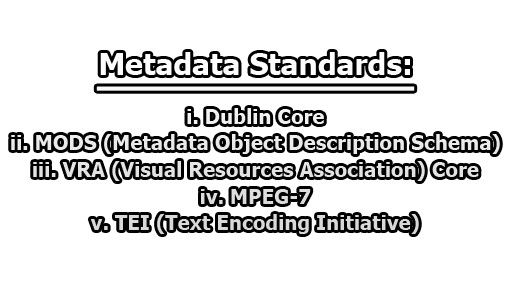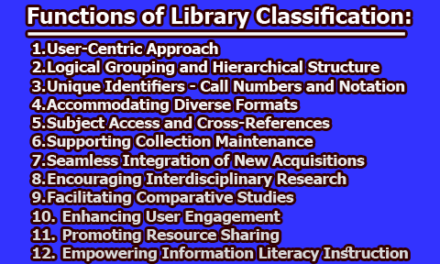Metadata Standards:
Metadata standards are guidelines or specifications that define the structure, content, and format of metadata. The main purpose of metadata standards is to ensure consistent and accurate description of digital resources and to facilitate the discovery, exchange, and management of information. Here are some commonly used metadata standards in detail:
i. Dublin Core: This is one of the most widely adopted metadata standards for resource discovery. It provides a basic set of 15 metadata elements, including title, creator, subject, and description, that can be used to describe a wide range of resources, such as books, websites, photographs, and videos. The 15 metadata elements defined by the Dublin Core Metadata Initiative are:
- Title: A name given to the resource.
- Creator: The person(s) or organization(s) responsible for creating the resource.
- Subject: A topic or keywords that describe the resource.
- Description: A brief narrative that summarizes the resource.
- Publisher: The person(s) or organization(s) responsible for making the resource available.
- Contributor: Person(s) or organization(s) that have made contributions to the resource.
- Date: The date the resource was created or made available.
- Type: The nature or genre of the resource.
- Format: The physical or digital form of the resource.
- Identifier: A string or number used to uniquely identify the resource.
- Source: The resource from which the described resource is derived.
- Language: The language(s) in which the resource is expressed.
- Relation: Relationships between the resource and other resources.
- Coverage: The extent or scope of the resource, including spatial and temporal aspects.
- Rights: Information about rights held in and over the resource.
These elements provide a basic set of descriptive information that can be used to describe a wide range of resources and make them more discoverable and accessible to users. The Dublin Core metadata elements are widely adopted and recognized as a standard for resource discovery and metadata management.
ii. MODS (Metadata Object Description Schema): This standard is used for descriptive metadata for library materials, including books, serials, sound recordings, moving images, cartographic materials, computer files, and electronic resources. MODS provides a more detailed set of metadata elements than Dublin Core and is used primarily in library catalogs and archives.
iii. VRA (Visual Resources Association) Core: The VRA Core metadata standard provides a comprehensive set of metadata elements for describing visual resources, such as images, artifacts, and architecture. It covers areas such as cultural context, materials, techniques, and style.
iv. MPEG-7: This standard provides a framework for describing multimedia content, including audio, video, and images. MPEG-7 metadata includes information such as color, shape, and texture description, as well as semantic information about the content, such as genre and subject matter.
v. TEI (Text Encoding Initiative): This standard is used for the encoding of electronic texts, including novels, poetry, and historical documents. TEI provides a rich set of metadata elements for describing the structure and content of texts, as well as their physical and intellectual context.
It is apparent that metadata standards play a crucial role in the organization, preservation, and discovery of digital resources. The use of metadata standards helps to ensure the consistency and interoperability of metadata across different systems and platforms, making it easier for users to locate and access the information they need.
Metadata Protocols:
Metadata protocols are technical specifications that define how metadata should be communicated, shared, and processed between different systems and applications. These protocols ensure that metadata can be exchanged between different systems in a consistent and standardized way, making it easier to discover, access, and manage digital resources. Here are some commonly used metadata protocols in detail:
a. OAI-PMH (Open Archives Initiative Protocol for Metadata Harvesting): This is a widely used protocol for metadata harvesting that enables the exchange of metadata between digital repositories and other systems. OAI-PMH provides a standardized way for digital repositories to expose their metadata to other systems and for other systems to access and retrieve the metadata.
b. METS (Metadata Encoding and Transmission Standard): This standard provides a flexible and extensible framework for encoding descriptive, administrative, and structural metadata about digital objects. METS is widely used for digital preservation and repository management and provides a standardized way for metadata to be stored, transferred, and managed along with digital content.
c. SIP (Submission Information Package) and AIP (Archival Information Package): These standards are used in the context of digital preservation to provide a structured way of packaging and transferring digital objects and their associated metadata between systems. The SIP standard defines the structure and format of the submission information package, while the AIP standard defines the structure and format of the archival information package that is stored in the digital repository.
d. SAML (Security Assertion Markup Language): This standard provides a way for exchanging authentication and authorization information between different systems. SAML is widely used in the context of metadata management to provide secure access to metadata and to ensure that only authorized users have access to sensitive information.
e. RDF (Resource Description Framework): This is a standard for modeling and exchanging metadata on the web. RDF provides a way to represent metadata as a set of triples, with each triple consisting of a subject, predicate, and object. RDF enables metadata to be linked and integrated across multiple systems and applications.
In conclusion, metadata protocols play a crucial role in enabling the interoperability, discoverability, and management of digital resources. By providing a standardized way for metadata to be shared and exchanged between different systems, metadata protocols help to ensure that metadata is consistent, accurate, and accessible, enabling users to more easily find and use the information they need.

Assistant Teacher at Zinzira Pir Mohammad Pilot School and College










